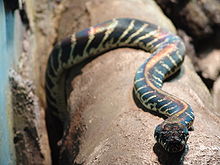Simalia boeleni
This article needs additional citations for verification. (August 2021) |
| Simalia boeleni | |
|---|---|

| |
| Scientific classification | |
| Domain: | Eukaryota |
| Kingdom: | Animalia |
| Phylum: | Chordata |
| Class: | Reptilia |
| Order: | Squamata |
| Suborder: | Serpentes |
| Family: | Pythonidae |
| Genus: | Simalia |
| Species: | S. boeleni
|
| Binomial name | |
| Simalia boeleni (Brongersma, 1953)
| |
| Synonyms | |
Simalia boeleni is a species of python, a nonvenomous snake in the family Pythonidae. The species is endemic to the mountains of New Guinea.[1][4] No subspecies are recognized.[3][5] Its common names include Boelen's python[1][4] and the black python.[1][3]

Etymology
The specific name, boeleni, is in honor of K.W.J. Boelen, M.D., who collected the holotype specimen.[6][7]
Description
In S. boeleni adults, the upperside color pattern is dark bluish-black or purplish-black, and the anterior part of the underside is white to pale yellow. The white extends up the flanks as a series of streaks. The upper and lower lips are also patterned with pale or whitish
Conservation status
The unmistakable and famed Boelen's python receives the highest legal protection possible in
Common names
Locally, S. boeleni is also known as the blu moran or papa graun. Within Indonesia, it has several names depending on which language is used. The common Indonesian names of this snake are sanca hitam, sanca bulan, piton hitam, and ular buleni.[citation needed]
Geographic range
S. boeleni is found in
]The
Habitat
S. boeleni
Diet
The diet of S. boeleni consists of small mammals, ground-nesting birds,[1] and lizards.[citation needed]
Captivity
S. boeleni is considered to be highly desirable by private keepers due to its beauty, but is also exceptionally rare in collections.[10] Although captive-born snakes are fairly hardy in captivity,[11] wild-caught individuals are considerably more difficult to keep successfully.[12] Captive breeding is exceedingly rare, and the conditions necessary are still unclear.[13] Many specific strategies have been employed to attempt to get these rare snakes to breed.[14]
References
- ^ . Retrieved 19 November 2021.
- ^ ISBN 1-893777-01-4(volume).
- ^ a b c Simalia boeleni at the Reptarium.cz Reptile Database. Accessed 20 October 2015.
- ^ ISBN 0-8069-6460-X.
- ^ "Morelia boeleni ". Integrated Taxonomic Information System. Retrieved 20 October 2015.
- ^ Brongersma, 1953. p. 317.
- ISBN 978-1-4214-0135-5. (Morelia boeleni, p. 29).
- ^ "Description of Natural History and Geography By Marc A. Spataro". www.boelenspythons.com. Archived from the original on 24 June 2015. Retrieved 29 August 2016.
- ^ Spataro, Marc. "Natural History". Boelens Python Group. Archived from the original on 23 February 2019. Retrieved 27 February 2019.
- ^ "The Boelen's Python Group WELCOME". www.boelenspythons.com. Archived from the original on 8 July 2011. Retrieved 3 March 2011.
- ^ "HATCHLINGS/SUB-ADULTS By Marc A. Spataro". www.boelenspythons.com. Archived from the original on 8 July 2011. Retrieved 3 March 2011.
- ^ "ACCLIMATING WILD-CAUGHTS By Marc A. Spataro". www.boelenspythons.com. Archived from the original on 8 July 2011. Retrieved 3 March 2011.
- ^ "Morelia boeleni Captive Reproduction By Marc A. Spataro". www.boelenspythons.com. Archived from the original on 8 July 2011. Retrieved 3 March 2011.
- ^ Spataro, Marc. "Reproductive Strategies". Boelen's Python Group. Archived from the original on 23 February 2019. Retrieved 27 February 2019.
Further reading
- Flagle, Ari R.; Stoops, Erik D. (2009). Black python: Morelia boeleni. (Contributions to Natural History, Vol. 26). Frankfurt: Chimaira Buchhandelsgesellschaft mbh. 160 pp. ISBN 9783930612864.
- Brongersma LD (1953). "Zoology Notes on New Guinean Reptiles and Amphibians II". Proc. Koninklijke Nederlandse Akademie van Wetenschappen, Amsterdam (Series C) 56: 317–325. (Liasis boeleni , new species, p. 317.)
External links
- Boelen's python site & forums.
- Boelen's Python Site by Ari R. Flagle.

